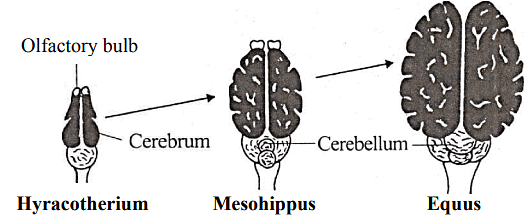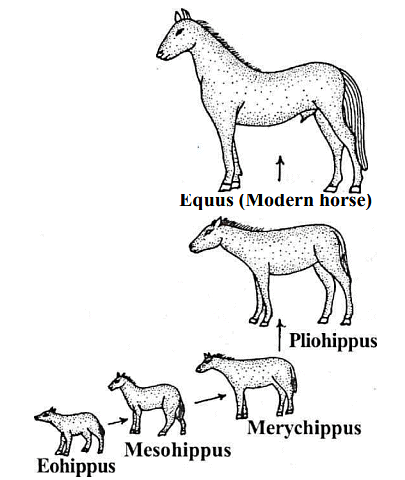Evolution of Horse | Zoology Optional Notes for UPSC PDF Download
| Table of contents |

|
| Introduction |

|
| Ancestral Stock |

|
| Evolutionary Sequence of Horses |

|
| Orthogenesis in Horse Evolution |

|
Introduction
Horses, belonging to the order Perissodactyla, are peculiar odd-toed hoofed mammals. Their evolution represents a distinctive straight-line progression, serving as a prime example of orthogenesis. Commencing during the Eocene period, this evolutionary journey unfolds predominantly in North America.
Place of Origin
The cradle of horse evolution lies in North America. Initial migration routes led horses to Europe and Asia. However, by the conclusion of the Pleistocene period, horses faced extinction in their native North America. Present-day North American horses are descendants of migrants from other continents.
Time of Origin
The genesis of horse evolution dates back approximately 58 million years, marking the onset of the Eocene period within the Cenozoic era. The modern Equus species, as we recognize it, emerged during the Pleistocene period around 2 million years ago.
Evolutionary Trends
Fossil evidence indicates progressive changes in horse anatomy over various epochs, embodying specific evolutionary trends:
- Increase in Size
- Lengthening of Limbs
- Extension of Neck Length
- Expansion of Preorbital Region (Face)
- Augmentation of III Digit Length and Size
- Enhancement in Brain Size and Complexity
- Molarization of Premolars
- Development of High Crowns in Premolars and Molars
- Shift from Plantigrade to Unguligrade Gait
- Formation of Diastema
- Vanishing of Lateral Digits
- Enlargement of Hoof on the Middle Digit
- Introduction of Springing Mechanism
- Straightening and Stiffening of the Back
- Transition from Browsing to Grazing Habit
 Evolution of brain in horse.
Evolution of brain in horse.
Ancestral Stock
Modern horses trace their lineage to the Mammalia class, specifically Tetraclaeonodon, encompassed in the order Condylartha. All members of this order share a common trait—being five-toed, hoofed ungulates.
Evolutionary Sequence of Horses
The North American theater witnessed the evolution of horses over distinct epochs:
- Eocene Period: Tetraclaeonodon, a five-toed animal, serves as the ancestral horse.
- Eocene to Oligocene: Hyracotherium (Eohippus), Orohippus, and Epihippus—representative of Eocene horses.
- Oligocene to Miocene: Mesohippus and Miohippus emerge.
- Miocene: Parahippus and Merychippus, indicative of Miocene horses.
- Pleistocene: Pliohippus precedes the emergence of the modern horse Equus around 2 million years ago in North America.
Evolutionary Overview
The fossil record provides a comprehensive insight into the evolution of horses, offering a continuum from the first horse, Eohippus, to the modern Equus. Each stage in this evolutionary journey is marked by distinct species, reflecting a gradual transformation over time.
1. Eohippus or Hyracotherium - Eocene Horses
- Often referred to as the "dawn horse," Eohippus lived during the Eocene period in North America.
- Salient features of Hyracotherium:
- Height: Only 10 inches, akin to the size of a fox.
- Habitat: Forest-dwelling browser, consuming soft vegetation.
- Limbs: Digitigrade, with four forelimb digits and three hindlimb digits.
- Back: Arched and flexible.
- Dentition: Brachyodont (low crowned) with 44 teeth.
- Brain: Small and smooth cerebral hemispheres.
- Eohippus gave rise to Orohippus, Epihippus, and Mesohippus during the Eocene period. Mesohippus, on the main line of evolution, persisted until the end of Oligocene.
2. Orohippus - Eocene Horse
- Originated from Eohippus, became extinct in late Eocene.
- Often called the "mountain horse" and slightly taller than Eohippus.
- Evolutionary similarities with Eohippus, with the disappearance of splint bones from both limbs.
3. Epihippus - Eocene Horse
- Third Eocene horse, originating from Orohippus, became extinct by the end of Eocene.
- Slightly larger than Orohippus, featuring molar-like last two premolars.
- Maintained a browsing habit.
 Evolution of horse.
Evolution of horse.
 Changes in the fore limb of horse.
Changes in the fore limb of horse.
4. Mesohippus - Oligocene Horse
- On the main line of evolution, leading to modern horses, became extinct by the end of Oligocene.
- Salient features:
- Size: About the size of a sheep, 18 to 24 inches in height.
- Limbs: All legs with three digits, V digit represented by a splint in forelimbs.
- Elongation: Limbs elongated due to lengthening of metacarpals and metatarsals.
- Dentition: Last two premolars molar-like, brain exhibiting increased complexity.
5. Miohippus - Late Oligocene Horse
- Lived at the end of Oligocene, slightly larger than Mesohippus.
- Direct ancestor to modern horses and many extinct horses.
- Gave rise to two lines: Parahippus (leading to modern horses) and Anchitherium (leading to Hypohippus).

Changes in the hind limb of horse.
6. Parahippus - Miocene Horse
- Descended from Miohippus, lived during Miocene.
- Salient features:
- Browser with much-elongated preorbital region.
- Molar-like premolars and hypsodont dentition.
- Three toes in the legs, with the middle toe prominent.
7. Merychippus - Miocene Horse
- Descendant of Parahippus, the first three-toed grazer.
- Transitional stage between browsers and grazers.
- Salient features:
- Adapted to grassland, feeding on grasses.
- Limbs with three toes, only the middle toe touching the ground.
- Well-developed hoof in the middle digit.
- Complex and convoluted cerebral hemispheres.
 Showing the evolution of horse.
Showing the evolution of horse.
8. Hipparion - Pliocene Horse
- A three-toed grazer from the Pliocene period.
- Gave rise to Stylohipparion and became extinct by the upper Pleistocene.
9. Pliohippus - Pleistocene Horse
- Direct descendant of Merychippus, on the main line of evolution leading to the modern horse.
- The first one-toed horse, with reduced side toes represented by splint bones.
10. Equus - Modern Horse
- Originated in the Pleistocene, descended from Pliohippus.
- Evolutionary changes include increased height, enlarged middle toe with a well-developed hoof, and adapted for grazing.
- Evolved primarily in North America, the motherland of horses, but became extinct in the region by the end of the Pleistocene. Present-day North American horses were introduced by humans.
Orthogenesis in Horse Evolution
- The horse's evolutionary history exemplifies orthogenesis, characterized by a straight-line evolution.
- Despite some opposition, the selected fossil horses represent a direct line of evolution, while many side branches became extinct at various periods.
- Simpson's (1953) viewpoint emphasizes that orthogenesis may be more a product of scientists' linear thinking than a natural tendency.
|
198 videos|351 docs
|
FAQs on Evolution of Horse - Zoology Optional Notes for UPSC
| 1. What is the ancestral stock of horses? |  |
| 2. What is the evolutionary sequence of horses? |  |
| 3. What is orthogenesis in horse evolution? |  |
| 4. How did the evolution of horses occur? |  |
| 5. How does the evolution of horses relate to the UPSC exam? |  |















